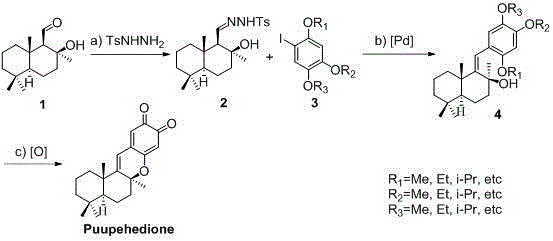Synthesis method of marine natural product Puupehedione
A technology of natural products and synthetic methods, applied in the direction of organic chemistry, etc., can solve the problems of long reaction route, low yield, unsuitable for industrial production, etc., and achieve the effect of high total yield, good product selectivity, and few reaction steps
- Summary
- Abstract
- Description
- Claims
- Application Information
AI Technical Summary
Problems solved by technology
Method used
Image
Examples
Embodiment 1
[0017] Example 1: Synthesis of Perilla Hydrazone (2, see accompanying drawing)
[0018] Dissolve 2.38 g (1, 10.0 mmol) of (+) sclarealdehyde in 30 ml of anhydrous methanol, add 1.86 g (10.0 mmol) of p-toluenesulfonyl hydrazide, stir and react at room temperature for 3 hours, and TLC detects that the reaction is complete. After concentration, 3.98 g of white solid (+) clarylasulfonylhydrazone was obtained, with a yield of 98%.
Embodiment 2
[0019] Embodiment 2: the synthesis of skeleton compound (4, see accompanying drawing)
[0020] Take (+) 2.03 g (2, 5.0 mmol) of clarylar sulfonylhydrazone and dissolve it in 25 ml of anhydrous tetrahydrofuran, add 144 mg (0.125 mmol) of tetraphenylphosphine palladium and 2.07 g (15 mmol) of potassium carbonate and repeatedly charge Argon was purged three times to exhaust the air. Another 1.47 g (3.5 mmol) of iodo-1,2,4-trimethoxybenzene was dissolved in 5 ml of anhydrous tetrahydrofuran, slowly added dropwise to the above reaction system, and the temperature was raised to 110 o C, the reaction was stirred for 10 hours, and the reaction was detected by TLC. Add 50 ml of water to the reaction system, extract with ethyl acetate (30 mL x 3), combine the organic phases, wash with saturated brine, dry over anhydrous sodium sulfate, filter, concentrate, and purify by column chromatography to obtain 1.47 g of white solid, The yield was 76%.
Embodiment 3
[0021] Embodiment 3: the synthesis of natural product Puupehedione (see accompanying drawing)
[0022] Take 1.16 g (4.3 mmol) of the skeleton compound and dissolve it in 10 ml of acetonitrile, cool to 0 o C. Take 3.29 g (6 mmol) of ammonium cerium nitrate and dissolve it in 20 ml of water, add the aqueous solution of ammonium cerium nitrate dropwise to the above system, stir and react for 0.5 hours, and TLC detects that the reaction is complete. Add 10 ml of water to the reaction system, extract with ethyl acetate (20 mL x 3), combine the organic phases, wash with saturated brine, dry over anhydrous sodium sulfate, filter, concentrate, and purify by column chromatography to obtain 568 mg of a red solid, The yield was 58%. = 51 (c = 0.087 in MeOH); IR (film): ν max = 2922, 2359, 1653, 1646, 1603,1559, 1457, 1393, 1229, 1065, 668 cm−1; 1H NMR (400 MHz, CDCl3): δ = 6.31 (s,1H), 6.12 (s, 1H) , 5.95 (s, 1H), 1.54 (s, 3H), 1.24 (s, 3H), 0.96 (s, 3H),0.89 (s, 3H) ppm; 13C NMR (1...
PUM
 Login to View More
Login to View More Abstract
Description
Claims
Application Information
 Login to View More
Login to View More - Generate Ideas
- Intellectual Property
- Life Sciences
- Materials
- Tech Scout
- Unparalleled Data Quality
- Higher Quality Content
- 60% Fewer Hallucinations
Browse by: Latest US Patents, China's latest patents, Technical Efficacy Thesaurus, Application Domain, Technology Topic, Popular Technical Reports.
© 2025 PatSnap. All rights reserved.Legal|Privacy policy|Modern Slavery Act Transparency Statement|Sitemap|About US| Contact US: help@patsnap.com

